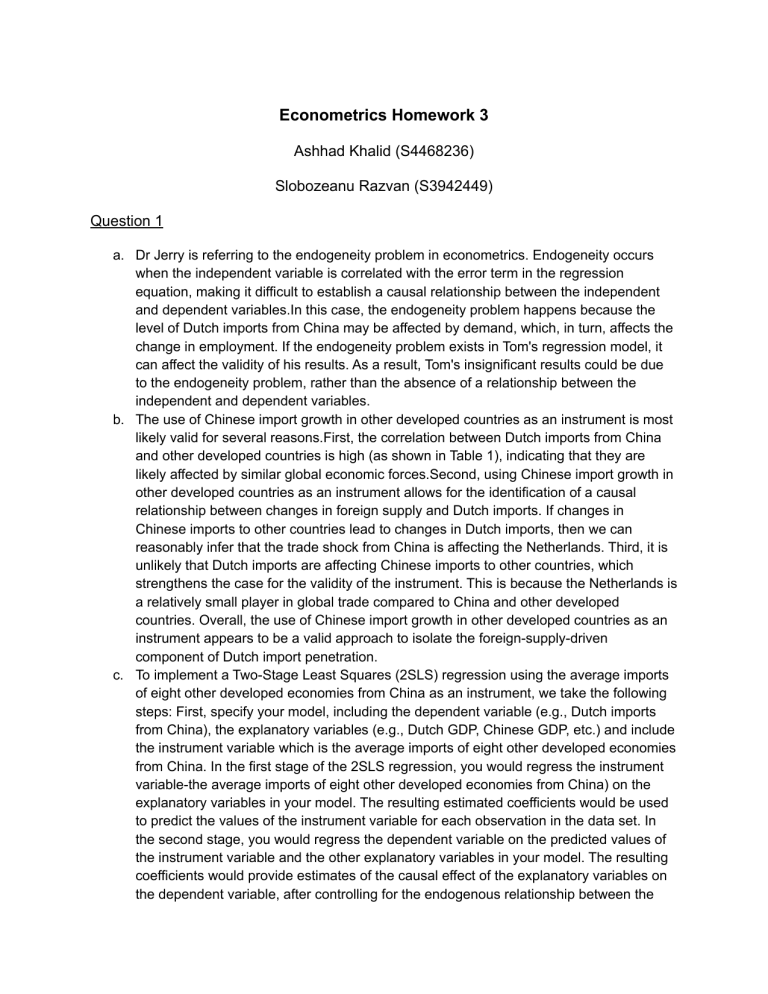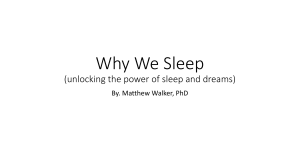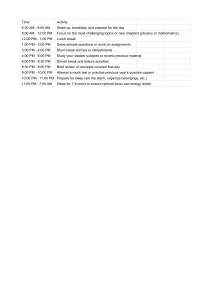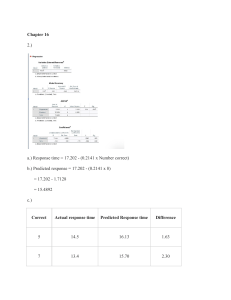
Econometrics Homework 3 Ashhad Khalid (S4468236) Slobozeanu Razvan (S3942449) Question 1 a. Dr Jerry is referring to the endogeneity problem in econometrics. Endogeneity occurs when the independent variable is correlated with the error term in the regression equation, making it difficult to establish a causal relationship between the independent and dependent variables.In this case, the endogeneity problem happens because the level of Dutch imports from China may be affected by demand, which, in turn, affects the change in employment. If the endogeneity problem exists in Tom's regression model, it can affect the validity of his results. As a result, Tom's insignificant results could be due to the endogeneity problem, rather than the absence of a relationship between the independent and dependent variables. b. The use of Chinese import growth in other developed countries as an instrument is most likely valid for several reasons.First, the correlation between Dutch imports from China and other developed countries is high (as shown in Table 1), indicating that they are likely affected by similar global economic forces.Second, using Chinese import growth in other developed countries as an instrument allows for the identification of a causal relationship between changes in foreign supply and Dutch imports. If changes in Chinese imports to other countries lead to changes in Dutch imports, then we can reasonably infer that the trade shock from China is affecting the Netherlands. Third, it is unlikely that Dutch imports are affecting Chinese imports to other countries, which strengthens the case for the validity of the instrument. This is because the Netherlands is a relatively small player in global trade compared to China and other developed countries. Overall, the use of Chinese import growth in other developed countries as an instrument appears to be a valid approach to isolate the foreign-supply-driven component of Dutch import penetration. c. To implement a Two-Stage Least Squares (2SLS) regression using the average imports of eight other developed economies from China as an instrument, we take the following steps: First, specify your model, including the dependent variable (e.g., Dutch imports from China), the explanatory variables (e.g., Dutch GDP, Chinese GDP, etc.) and include the instrument variable which is the average imports of eight other developed economies from China. In the first stage of the 2SLS regression, you would regress the instrument variable-the average imports of eight other developed economies from China) on the explanatory variables in your model. The resulting estimated coefficients would be used to predict the values of the instrument variable for each observation in the data set. In the second stage, you would regress the dependent variable on the predicted values of the instrument variable and the other explanatory variables in your model. The resulting coefficients would provide estimates of the causal effect of the explanatory variables on the dependent variable, after controlling for the endogenous relationship between the dependent variable and the instrument variable. Finally, we do some tests to check the validity of the instrument variable, such as examining the F-test for the first-stage regression (which should be greater than 10). d. The graph portrays a high residual difference as the years of education increase thus resulting in the predicted values being high. Additionally, it is possible that the multiple regression model suffers from a violation of the assumption of no multicollinearity between the independent variables, specifically between "educ" and "educ*exper". This is because the model includes an interaction term between "educ" and "exper", which means that the effect of education on wages may vary depending on years of experience. However, if there is also a high correlation between "educ" and "educ*exper", then it becomes difficult to disentangle the separate effects of education and experience on wages, and the estimates for both variables may become unreliable. e. Yes, the residuals for a given level of education are much lesser than before. By taking a log function it is possible that they addressed the problem of multicollinearity between "educ" and "educ*exper". This is because taking the logarithm of the dependent variable can help to "spread out" the differences between predicted values of the variable, which can help to reduce the correlation between the interaction term and the main effect of education. Using logarithms on the dependent variable can have several potential beneficial consequences: (i)Non-linear relationships: Taking the logarithm of a variable can help to capture non-linear relationships between the variable and the dependent variable. (ii)Homoscedasticity: Transforming the dependent variable into logarithmic form can help to address the issue of heteroscedasticity, which occurs when the variance of the dependent variable is not constant across different levels of the independent variables. (iii)Interpretation: Taking the logarithm of the dependent variable can make the results of the regression more easily interpretable. f. d(wage)/d(educ) = 0 + 0.0464 + 0.003081 * exper + 0.00000 - 0 = 0.0464 + 0.003081 * exper Plugging in exper = 8 results in d(wage)/d(educ) = 0.071. This means that at 8 years of experience, an extra year of education results in an increase in wages of 7.1%. g. Not including intelligence in the regression model can bias the effect of education on wages because intelligence is likely to be correlated with both education and wages.If intelligence is omitted from the model, the coefficient for education will take its place and be skewed, possibly overestimating intelligence's impact on wages.This is because the effect of education on wages may be partly or entirely due to the effect of intelligence on both education and wages. To achieve a more accurate approximation of the true influence of education on wages, adjusting for intelligence is crucial. Question 2 (a) We used the command “encode” to destring the variables which are in string format (Gender, Smokingstatus, Sleepduration, Exercisefrequency). For variables Gender, we recode that Male = 1 and Female = 0. We did the same for Smokingstatus, if a person smokes the variable is equal to one, and if not equal to 0. Descriptive Statistics Variable Obs Mean Std.Dev. Min Max ID 458 229.5 132.357 1 458 Age 458 40.207 13.137 9 69 Sleepeffic~y 458 1.019 4.594 .5 99 Awakenings 438 1.648 1.355 0 4 Caffeineco~n 433 23.388 30.095 0 200 Alcoholcon~n 442 1.249 1.639 0 5 gender_num 458 .507 .501 0 1 Smokingsta~m 458 .358 .48 0 1 Sleepdurat~m 458 5.86 1.552 1 9 Exercisefr~m 458 3.793 1.509 1 9 The table provides descriptive statistics for a dataset of 458 observations and nine variables. The "Sleepefficiency" variable represents the proportion of time spent in bed that is spent asleep and ranges from 0.5 to 99, with a mean of 1.019 and a standard deviation of 4.594. The data for "Sleepefficiency" variable should range from 0 to 1. Still, in our model based on descriptive statistics, we can see that the max is 99, so we used the command “drop if Sleepeffciency >1” after, Stata deleted five observations that include measurement error. Variable Obs Mean Std.Dev. Min Max ID 453 228.057 131.603 1 458 Age 453 40.296 13.16 9 69 Sleepeffic~y 453 .789 .135 .5 .99 Awakenings 433 1.644 1.357 0 4 Caffeineco~n 428 23.598 30.189 0 200 Alcoholcon~n 437 1.243 1.643 0 5 gender_num 453 .506 .501 0 1 Smokingsta~m 453 .355 .479 0 1 Sleepdurat~m 453 5.852 1.549 1 9 Exercisefr~m 453 3.757 1.454 1 7 (b) Linear regression Sleepefficiency Coef. St.Err. t-value p-value [95% Conf Interval] Sig 0.019 0.004 4.95 0.000 0.011 0.026 *** gender_num -0.002 0.011 -0.15 0.879 -0.024 0.021 Age 0.001 0.000 1.25 0.213 0.000 0.001 -0.080 0.011 -7.05 0.000 -0.102 -0.057 *** -0.034 0.003 -10.37 0.000 -0.040 -0.027 *** 0.769 0.023 33.77 0.000 0.725 0.814 *** Exercisefrequenc y_~m Smokingstatus_nu m Alcoholconsumpti on Constant Mean dependent var 0.790 SD dependent var 0.135 R-squared 0.327 Number of obs F-test 41.876 Prob > F Akaike crit. (AIC) -673.555 Bayesian crit. (BIC) 437.000 0.000 -649.075 *** p<0.01, ** p<0.05, * p<0.1 The coefficient for "Exercisefrequency” (times/week) in the linear regression output represents the estimated effect of the predictor variable "Exercisefrequency" on the outcome variable "Sleepefficiency". Specifically, for each additional time per week an individual exercises, the sleep efficiency quality is estimated to increase by 0.019 units, holding all other predictor variables in the model constant. The coefficient is positive and statistically significant (indicated by the t-value of 4.95 and p-value of 0.000), which suggests that higher exercise frequency is associated with better sleep efficiency. This means that individuals who exercise more frequently are likely to have a better quality of sleep compared to those who exercise less frequently, after controlling for other variables in the model. It is important to note that the coefficient represents the estimated association between exercise frequency and sleep efficiency, and does not necessarily imply a causal relationship. There may be other factors that influence both exercise frequency and sleep efficiency, which were not included in the model, and could potentially confound the relationship. The variable “Gender” has a coefficient equal to -0.002 which indicates that for every one-unit increase in gender (i.e., from male to a female), the sleep efficiency is estimated to decrease by 0.002 units, holding all other predictor variables in the model constant. However, the coefficient for "gender" is not statistically significant (indicated by the t-value of -0.15 and p-value of 0.879). This means that there is not enough evidence to conclude that gender is associated with sleep efficiency in this model, after controlling for other variables such as exercise frequency, smoking status, alcohol consumption, and age. (c) Linear regression Sleepefficiency Coef. St.Err. t-value p-value [95% Conf Interval] Sig 0.020 0.005 4.05 0.000 0.010 0.030 *** 0.011 0.031 0.36 0.722 -0.050 0.072 -0.003 0.008 -0.44 0.659 -0.019 0.012 0.001 0.000 1.25 0.211 0.000 0.001 -0.079 0.011 -6.91 0.000 -0.101 -0.056 *** -0.034 0.003 -10.36 0.000 -0.040 -0.027 *** 0.764 0.026 29.75 0.000 0.714 0.815 *** Exercisefrequenc y_~m gender_num Exercisefreq_Gen der Age Smokingstatus_nu m Alcoholconsumpti on Constant Mean dependent var 0.790 SD dependent var 0.135 R-squared 0.327 Number of obs 437.000 F-test 34.864 Akaike crit. (AIC) -671.753 Prob > F 0.000 Bayesian crit. (BIC) -643.193 *** p<0.01, ** p<0.05, * p<0.1 In this updated model, a new variable "Exercisefreq_Gender" is included, which is the interaction between exercise frequency and gender. The coefficient for this variable is -0.003 with a p-value of 0.659, indicating that the interaction term is not significant. The coefficient -.003 suggests that there is no significant difference in the relationship between exercise frequency and sleep efficiency between males and females. In other words, the effect of exercise frequency on sleep efficiency is similar for both males and females..The coefficient for "Exercisefrequency_m" is still significant at 0.020 with a p-value of 0.000, indicating that for every unit increase in exercise frequency above the mean, sleep efficiency increases by 0.020 units on average, holding all other variables constant. The coefficient for "gender_num" is not significant at 0.011 with a p-value of 0.722, indicating that there is no significant difference in sleep efficiency between males and females, holding all other variables constant. The other variables in the model, "Age", "Smokingstatus_num", and "Alcoholconsumption", have coefficients that are similar to the previous model and are all significant at the 0.01 level. (d) Linear regression Sleepefficiency Coef. St.Err. t-value p-value [95% Conf Interval] Sig 0.008 0.004 1.89 0.059 0.000 0.017 * 0.009 0.026 0.34 0.738 -0.043 0.060 0.000 0.007 0.05 0.958 -0.013 0.013 0.001 0.000 1.57 0.117 0.000 0.001 -0.087 0.010 -9.03 0.000 -0.106 -0.068 *** -0.027 0.003 -9.45 0.000 -0.032 -0.021 *** Awakenings -0.048 0.004 -13.52 0.000 -0.055 -0.041 *** Constant 0.873 0.023 37.40 0.000 0.827 0.919 *** Exercisefrequenc y_~m gender_num Exercisefreq_Gen der Age Smokingstatus_nu m Alcoholconsumpti on Mean dependent var 0.790 SD dependent var 0.135 R-squared 0.545 Number of obs 417.000 F-test 70.021 Prob > F Akaike crit. (AIC) -798.291 Bayesian crit. (BIC) 0.000 -766.026 *** p<0.01, ** p<0.05, * p<0.1 The coefficient of "alcohol consumption" in the previous model was -0.034, while in the current model that includes "awakenings," it is -0.027. The difference in these coefficients is small, but it suggests that the relationship between alcohol consumption and sleep efficiency may be slightly weaker when accounting for the effect of awakenings. However, it is important to note that the coefficient is still negative and statistically significant, indicating that higher levels of alcohol consumption are associated with lower sleep efficiency, even after controlling for other variables such as exercise frequency, gender, age, and smoking status. Overall, which model to choose depends on the research question and the purpose of the analysis. If the goal is to understand the relationship between alcohol consumption and sleep efficiency while controlling for other factors, the current model that includes awakenings may be more appropriate. However, if awakenings are irrelevant to the research question, the previous model that only includes exercise frequency, gender, age, smoking status, and alcohol consumption may be sufficient. (e) Linear regression Sleepefficiency Coef. St.Err. t-value p-value [95% Conf Interval] 0.006 0.004 1.27 0.203 -0.003 0.014 0.000 0.026 -0.01 0.992 -0.052 0.051 Exercisefrequency _~m gender_num Sig 0.003 0.007 0.48 0.629 -0.010 0.016 Age 0.006 0.002 2.83 0.005 0.002 0.010 *** age_squared 0.000 0.000 -2.61 0.009 0.000 0.000 *** -0.087 0.010 -9.06 0.000 -0.106 -0.068 *** -0.026 0.003 -9.05 0.000 -0.031 -0.020 *** Awakenings -0.047 0.004 -13.51 0.000 -0.054 -0.040 *** Constant 0.777 0.044 17.80 0.000 0.691 0.863 *** Exercisefreq_Gend er Smokingstatus_nu m Alcoholconsumpti on Mean dependent var 0.790 SD dependent var 0.135 R-squared 0.553 Number of obs 417.000 F-test 62.986 Prob > F Akaike crit. (AIC) -803.181 Bayesian crit. (BIC) 0.000 -766.884 *** p<0.01, ** p<0.05, * p<0.1 The coefficient for the variable age^2 is 0.000, and it is statistically significant at the 0.01 level. This indicates that there is a non-linear relationship between age and sleep efficiency. Specifically, the coefficient suggests that as age increases, the effect of age on sleep efficiency first increases, and then decreases. This type of relationship is called a "U-shaped" relationship, where the effect of the independent variable first increases and then decreases as it changes. In this case, it suggests an age at which sleep efficiency is maximized, and beyond that age, sleep efficiency starts to decline. However, to determine at what age the effect of age on sleep efficiency is maximized, further analysis or visualization is needed: The scalar command Age_max calculates the age at which the effect of age on sleep quality is maximised. The formula used to calculate this is based on the coefficients for age and age squared in the last regression model. The result of the calculation is 44.9 years old, which means that the effect of age on sleep quality is maximized at this age. This result suggests that as individuals age beyond this age, the effect of age on sleep quality starts to diminish.





